Impact
Our Impact
Video Volunteers has initiated and sustained a global community media movement, which has empowered people by giving them a voice, training them to use it, and enabled them to take action towards social change. Our training models and projects have created an impact in the following ways:
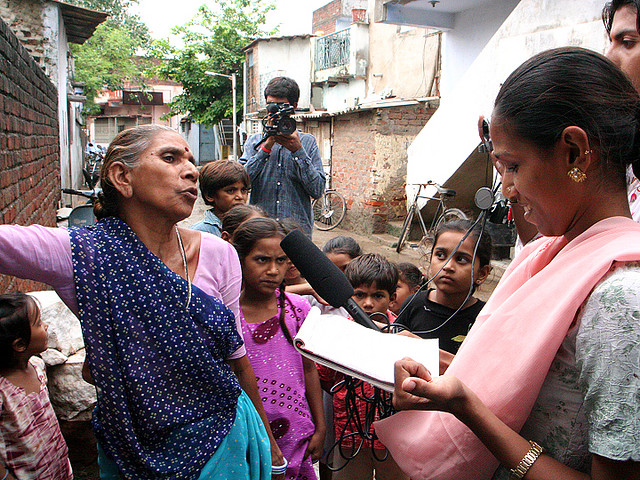
Give the poor a voice.
- Enable the poor to participate in decision-making.
- Create platforms for constructive dialogue and discussion around screenings of their films, where people focus on solutions not problems.
- Change the lens of looking—from outsiders looking in, to insiders voicing out. This has helped in dashing dominant ideology stereotypes and offered the poor a chance to be the creators of content.
- Strengthened this voice by creating networks of community producers and correspondents who know and work with each other.
- Integrated this voice with mainstream media, allowing for the representation of the poor as producers of information.
Promote community-led development, enable communities to take action on their issues, and provide critical information to people who don’t have it.
The first step in changing the way people behave is to change the way they think. Once people are informed, or issues are brought to the surface from within, possible solutions can be discussed and they can start to organize. It also brings awareness to people of their rights, a better understanding of the problems their communities face and different approaches to tackling issues. Examples of responses to videos produced by Community Producers and Correspondents include:
- The upper-caste employers in a village started paying the minimum wage after community members learned the exact pay they were entitled to from a community-produced film.
- The Bhagwati Hotel in Choraniya village was forced to reconstruct its sewage system so that it didn’t empty into the village’s drinking water pipes.
- Villagers organized clean-up rallies in three villages after watching a CVU film on cleanliness in Surendranagar district Gujarat.
[expand title=”Click here to expand list”]
- Local villagers started demanding that the local moneylender charge them the proper rates.
- Children belonging to different communities played together for the first time after a video on equal rights.
- Villagers protested against the selling and consumption of alcohol; five villagers announced abstinence from alcohol and there were raids on illegal liquor shops in Jakhan village.
- 20 people working in the unorganized sector, filled forms to start a union in the two Bombay slums of Dharavi and Malad.
- Villagers demanded quicker processing of malaria samples and the doctors responded.
- In Doramamidi, villagers staged protests regarding their lack of electricity in front of the Electric Department, and as a result got electricity.
- A video for IndiaUnheard resulted in horse cart drivers being given an official parking spot in Allahabad.
- A CVU producer’s father gave up alcohol addiction.
- Numerous calls made to NGOs to organize youth sports teams after seeing a film on women’s access to public space that advocated girls sports teams.
- Children in a youth media workshop, organized by a CVU, took an inspirational video about playgrounds to local municipal authorities; it was then screened in schools in Ahmedebad.
- People urged doctors to conduct regular visits, and doctors started attending patients in 4 villages.
- Film on fuel and energy shown in 30 schools, raised awareness and concern amongst children.
- Film removed a fear of textbooks, enlightened children about rights, and gathered general knowledge about tribal culture, etc.
[/expand]
Advocate for democracy and an end to corruption, encourage governments and authorities to take action.
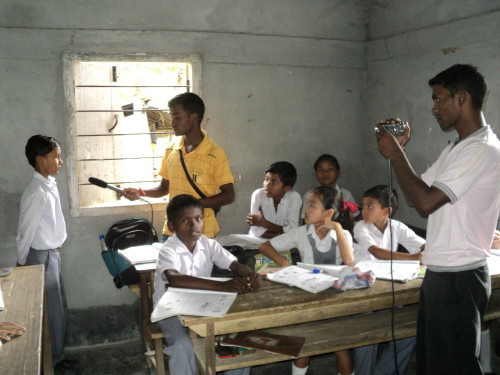
The camera can either be a weapon, exposing corruption, or it can be a bridge-building tool to local government officials who are disconnected from residents. Therefore, community video can strengthen democracy and encourage local people to participate in governance.
The Right to Information Act (RTI) is also an important part of the training for both CVU producers and India Unheard Community Correspondents—as a result the poor and marginalized are now using their constitutional rights and demanding information in order to take action. So far, more than 10 communities have successfully used RTI to get information and subsequently take action.
As well, people who know their rights are much more likely to exercise those rights. Armed with this knowledge, citizens have the courage to lobby government with authority on their own. The government, in turn, is much more likely to carry out its functions properly and improve the quality of its services because people are watching. Often times, the government has no choice but to respond to the mounting public pressure and fix the problem.
- The government re-opened a water treatment plant and brought clean water to 3,000 people after Community Producers exposed a high level of fluorine content resulting in florosis. Villagers agreed to invest in the treatment plant.
- Slum dwellers in Mumbai, after watching a film on Right To Information act (RTI) filed an RTI to find out the details of the budget spent on garbage clearance. The RTI resulted in quick clearance of the garbage and clogged drains.
- Attendance at local-governance Gram Sabha meetings increased from 7 to 40 in one village—these participative governance meetings are supposed to be composed of all villagers over the age of 18.
- In Ruupawati village, Dalit women expressed a desire to run for office in an election.
- Seven villages formed women’s panchayats (local councils).
[expand title=”Click here to expand list.“]
- Villagers demanded work under the government scheme NREGA (National Rural Employment Guarantee Act); 300 men and women got work for 100 days at Rs.50 per day.
- Forest Rights Recognition Act committees became active in all villages in which the video on this subject was screened.
- 60-70 children expressed their desire to vote after a film stressing the importance of democratic voting.
- A video for IndiaUnheard on paying bribes for education led to the Block Officer of that area demoting the Headmaster of the school.
- The government suspended a corrupt official running a ration shop as a result of villager’s demands.
- Food control officers, impressed by a film on ration cards, arranged for four Below Poverty Line ration cards to be given to deserving community members; raids resulted in more honest dealings.
- A community applied to the Integrated Tribal Development Agency to repair bore wells in 15-16 villages.
- Government paid the Samvad CVU to screen their magazine on tobacco abuse at the police headquarters.
- About 1200 people in Surendranagar village got toilets after villagers were informed it was their right to have proper sanitation.
- The government sanctioned a new road for the village Ravulapadu.
- Local government repaired the only road connecting several villages and allocated Rs.300,000 for further repairs.
- The government sent a team for an infrastructural inspection; toilets were built.
- In Surendranagar district, the government provided dustbins in one slum area and local people began working with rag-pickers to keep the area clean.
[/expand]
Expand the scale and reach of social programs and campaigns.
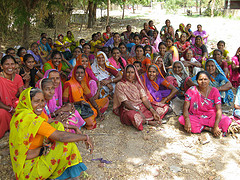
The CVU, with its ability to spread messages to large groups of people, is an efficient parallel strategy for our NGO partners. Screenings draw large crowds—on an average night between 200 and 300 people, which is sometimes the majority of a village. If a village needs drinking water, one solution would be to build a well. However, a more sustainable strategy would be to encourage 1000 people to demand clean water and get ten wells built that way.
Additionally, community videos and reports from the CVUs and IndiaUnheard correspondents often provide basic legal information, advice on government schemes, and even simple tips like the location of a local government agency. Many organizations have invested in our programs because they also enable them to listen to the community more closely and increase participation in their programs.
- 750 villagers filed reports of land rights violations with NGO staff in response to a film made for an NGO’s land rights campaign, significantly increasing the likelihood that those villages will become part of the government’s land reallocation program.
- There was three times the amount of participation in a Mumbai water campaign against the privatization of water for slum dwellers which led to a massive turn out at a public hearing by the government. As a result, privatization efforts were halted in these slums and water supply increased in two slums.
- There was a 150% increase in applications for a job-training program for youth after watching a film whose call to action was to apply to an NGO for this course.
[expand title=”Click here to expand list.“]
- The police hotline “103” was set up for sexual harassment in Mumbai, which has now extended to the entire state.
- 20 Parents’ Watch committees were started for better child care in Behrampure, Satosh Nagar, Ram Rahim Tekra.
- Six people joined Umeed (a vocational training centre for urban poor) for a 3-month course in Customer Relationship and Sales.
- 2000 students applied for courses run by the CVU’s sponsoring NGO, HIHT, after a film creating publicity for these academic courses.
- YUVA’s online supporter base doubled between 2007-2010 because of “Hamari Awaz” Community Video Unit.
- 600 people benefited from Byrajju’s bulletin on soil testing and traditional farming in Korukollu village.
- Education committees were formed in 5 villages to ensure special education rights to all the children of all the migrant laborers in the village.
- People demanded more information about drug rehabilitation programs from authorities.
- An Auxiliary Nurse Midwife began working properly after people warned her, as a result of a film on maternal health and immunization.
- Villagers started using Raitu Bazaar, a special market for farmers set up by the government.
- After learning about the opportunities available to them from watching Community Video Unit productions, people successfully accessed government loans.
- Children of migrant workers across 12 villages received migration cards, which entitled them to enroll short-term in schools in the areas where their parents were seasonal migrants, thus stopping them from dropping out of school.
- A video for IndiaUnheard on the dire lack of health care facilities in Manipur resulted in an NGO donating health supplies.
[/expand]
Transform the community members we work with into community leaders and in turn inspire others as role models.
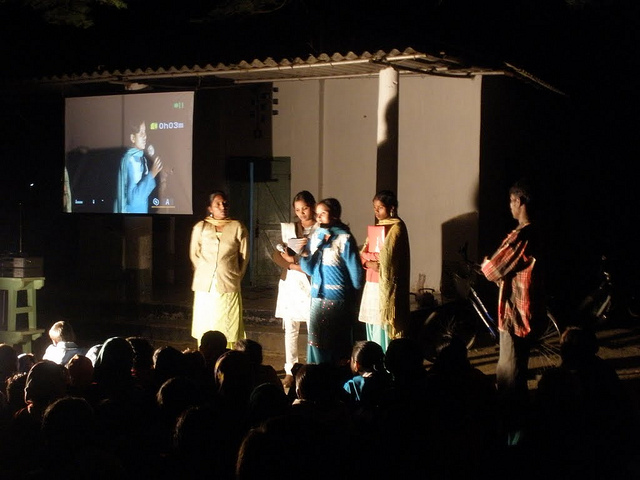
VideoVolunteers’ journalism training in critical thinking, confronting authority, asking questions and researching any issue, has created a new batch of leaders, of whom more than 50% are women. In all the communities where we work, these people become the “go-to-points” for conflict resolution, information and assistance. They are taught to open their eyes to new information, break down issues to root causes, and work through problems their villages are facing.
Community Producers and Correspondents undergo a remarkable transformation that re-shapes their lives. They are not simply video journalists; they are grassroots activists using the power of a compact camera. They are shedding light on people’s harsh realities, organizing communities, and empowering locals to take action. They are well respected in their villages and slums; they are a source of motivation for their peers and inspire others within their communities to also become leaders and positive role models.
- Dalit community producers, after addressing and exposing sensitive issues like land rights, are now respected by the rest of the community as leaders and invited into upper-caste spaces.
- Dalit Correspondents (like Mukesh) have been participating in national consultation on creation of livelihood opportunities for Dalits.
- Producers approached a public health officer to reopen a closed hospital in slum.
- Orthodox Muslim families enquired whether their daughters can work for the Samvad Community Video Unit.
- Villagers got together and created a Self Help Group to protect the water in the lakes and ponds in their community and to distribute it economically.
- Hindus and Muslims came together in one area for the first time since the Gujarat riots, to watch a film on communal harmony, and wished each other peace and happiness, ending fear in the minds of community members.
[expand title=”Click here to expand list.“]
- In Vasthadi, seven community women became actors for a CVU film on migration.
- A young Dalit musician from a slum in Bombay got a record deal after being featured in a Community Video Unit film in which he spoke about his dream of being a professional musician.
- CVU producers have been told by community members that they can use any house they want for their screenings.
- CVU producers got the head of a con-artist operation arrested.
- CVU producers found a rape victim, shot footage of the scene, took her to hospital and filed case. Police action was then made possible.
- Community Producer Neeru (of Navsarjan) was the only girl in her whole clan who, instead of having an arranged marriage, chose her own life partner (who is also a member of her CVU).
- Community Correspondents Rohini and Sunita broke the “purdah” system by becoming the first women to take up a job.
[/expand]
Create sustainable solutions and new business models for the base of the pyramid.
An important livelihood aspect underscores all of Video Volunteers’ training, and the skills learned can be applied across a lifetime. We have designed scalable and revenue-earning models for amplifying marginalized voices. The Community Video Units and IndiaUnheard correspondents have incredible market potential because they operate in areas where TV stations don’t normally have reporters, they have access to great stories, offer different perspectives, and can charge less that an urban “professional’ would. We continually research ways to create a media industry centered at the base of the pyramid.
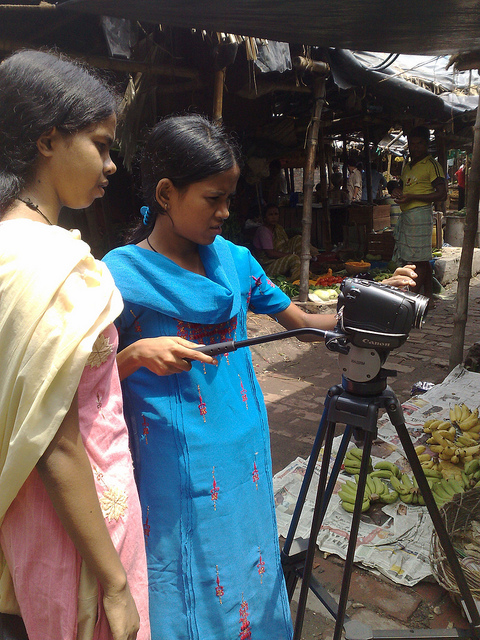
- CVU Producers earn a salary and are able to sustain themselves.
- IndiaUnheard Correspondents earn money for each video produced; they are also empowered to work as “news stringers” for the mainstream media.
- Our CVU Community Producers have now functioned for 4 years without the assistance of a full time trainer, demonstrating that it is possible for someone with little or no formal education to become an articulate journalist or filmmaker.
- The prestigious Indian Institute of Management (IIM) of Ahmedabad is collaborating with Video Volunteers to create business models, explore methods and design plans to help community media reach high levels of sustainability.
- Some CVUs are now earning income. Samvad earned 50% of its running costs this year—through revenue generating activities including making wedding videos in their spare time.
- Training videos have been fetching Rs.300 each.
- Our Brazil livelihood program enabled 8 community youth to set up a media collective through which they currently earn double their desired income level.
Redefine the paradigms of news and media control, impact the mainstream media and the NGO Landscape.
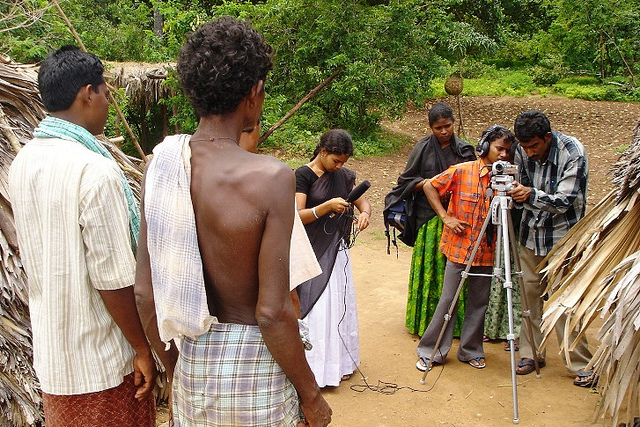 Video Volunteers believes in democratizing mainstream national and global media, although we see that much focus has been placed on funding and creating new ways for people to exchange knowledge without much investment in training community members to produce content or use these tools. New types of distribution platforms are popping up on a daily basis—from blogs to social media networks—and it is easy to assume that voices and perspectives from around the world are now flowing freely, however, many voices are still left out of the conversation. Thus, in order to further our mission of enabling communities to be the ones themselves articulating their needs, problems, and desires, we work hard to promote and distribute the media made by the communities we have given training to.
Video Volunteers believes in democratizing mainstream national and global media, although we see that much focus has been placed on funding and creating new ways for people to exchange knowledge without much investment in training community members to produce content or use these tools. New types of distribution platforms are popping up on a daily basis—from blogs to social media networks—and it is easy to assume that voices and perspectives from around the world are now flowing freely, however, many voices are still left out of the conversation. Thus, in order to further our mission of enabling communities to be the ones themselves articulating their needs, problems, and desires, we work hard to promote and distribute the media made by the communities we have given training to.
Video Volunteers also strengthens approaches to “bottom-up development” by enabling NGOs to listen to the voices of communities they work with and thus create more community-led development. As well, we provide NGOs with a way to achieve and complement their campaigns and assist them in spreading their ideas farther.
- Video Volunteers promotes diversity: our network of producers is ¼ Dalit, ¼ tribal, ¼ Muslim and over 50% female–thus bringing needed diversity to an Indian media that is largely of the Brahmin caste.
- More than 300 NGOs across India, Brazil, and the rest of the world, have expressed interest in being part of our programs, and ten NGOs have collectively invested more than $400,000 in our programs.
- We have trained and worked with more than 40 NGOs whose work is now more participatory, who are better able to listen to communities, and have stronger processes for engaging large numbers of people at the community level.
- We have interacted and cooperated with mainstream media. Our content has been featured on channels such as Current TV, CNN IBN, Pangea Day, Nickelodeon, NewsX and many others, demonstrating that community-produced content can influence even middle class audiences.
- Community Producer Jayasheela was selected by the international film competition Listen Up! To produce a video on her personal water struggle in her slum in Mumbai that was screened internationally in youth media markets and on America’s Public Broadcasting System (PBS). She also talks about how strong it made her feel to realize people were interested in their water struggles around the world.
[expand title=”Click here to expand list.“]
- We have generated significant interest in community media in India, signified by the Community Video Training Camp in Aug 2009, where there were 300 applications from NGOs, students and journalists for only 100 spaces.
- Video Volunteers was the past secretariat of the Community Radio Forum (CRF) and Stalin K is the former Convener of the forum. He was instrumental in the lobbying efforts, which led to the passage of the community radio broadcasting bill legalizing community radio for the first time in India, and was part of a team that drafted much of the new Community Radio Policy in operation today.
- Slum dwellers organized independent screenings of Community Video Unit films in their homes; politicians came to the NGO office asking for copies; it was covered in 12 major Mumbai newspapers.
[/expand]
[expand title=”Click here to read about how we measure our impact.“]
Impact Assessment
1) We measure the leadership development of the Community Producers and Correspondents through regular assessments of their skills and their videos.
2) We measure how communities take action in response to the videos they make and watch. Since each film ends with a concrete call to action, we can find out how many people actually followed it through.
3) We measure how the government takes action. Producers gather anecdotal impact stories related to communities and government in each village where they screened a film.
4) We measure the expansion in scale and reach of an NGO’s programs. This is measurable when the NGO has good comparison data. For instance, we have found that in films where the call to action is to join an NGO’s program (such as enroll in their livelihoods training program, or work with them to build toilets), enrollment has gone up by 75% in a few cases.
5) In the long term, we aim to create metrics to measure the long term impact on a community when it owns and controls its own media, though this is extremely challenging.
[/expand]

